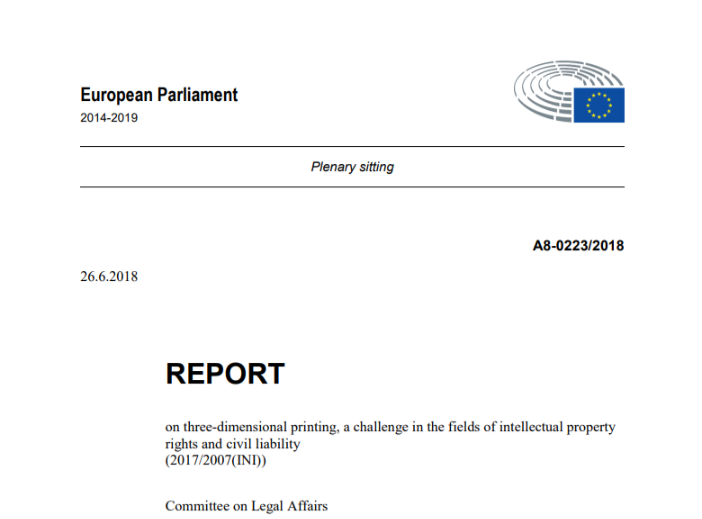The European Parliament has issued a resolution on 3D printing that experts warn could stifle innovation and lead to increased regulation.
The resolution is titled on three-dimensional printing, a challenge in the fields of intellectual property rights and civil liability and was adopted by with 631 votes in favour, 27 against and 19 abstentions.
Association calls for light-touch
CECIMO, the European Association representing the common interests of the Machine Tool Industries, has responded to the resolution. “We urge the European Institutions, however, to firmly differentiate between business-to-business (B2B) and business-to-consumer (B2C) uses of the technology, when approaching 3D printing from a regulatory perspective,” writes CECIMO
CECIMO recently published an activity report detailing initiatives to promote Additive Manufacturing.

In the new resolution the benefits of 3D printing, it’s potential and advances on the horizon are outlined, however a key section notes that a (potentially) surprising factor is holding back further progress and the widespread adoption – a lack of sufficient regulations.
This may appear counter intuitive, especially when the language of innovation is liberally sprinkled throughout the report. FabLabs are explicitly called out as a “boon for inventors.”
Resolution calls for increased regulation
However it is the “the aerospace and medical/dental sectors, [where] regulating the use of 3D printers will help increase the use of technologies and offer opportunities for research and development”.
Healthcare and aerospace are, rightly so, sectors where regulation is necessary to protect the safety of the public. Additive manufacturing has made slow,but steady progress as an acceptable technology in the aerospace industry. The certification and qualification process for the LEAP series jet engine and the 3D printed fuel nozzle is a poster child for the industry partly because of the scarcity of other components. Yet this does not mean the industry should seek to rush through more critical components. As one additive manufacturing for aerospace expert told me at Farnborough Airshow this week, the failure of an AM aerospace component could “kill the industry for ten years.”
CECIMO also highlights that additive manufacturing processes are already subject to the regulations governing the particular industry they are deployed in.
A response to the resolution by the European Commission is expected within the coming months.
The full resolution on 3D printing can be read here, while the response by CECIMO is available here.
For all the latest 3D printing news, subscribe to the 3D Printing Industry newsletter. Also, follow us on Twitter, and like us on Facebook.
Make your next additive manufacturing career move or hire new talent. Search and post 3D Printing Jobs on our free jobs service.

Selected highlights from the resolution
“3D printing is viewed as one of the most prominent technologies, with regard to which Europe can play a leading role; whereas the Commission recognised the benefits of 3D printing by sponsoring 21 projects based on the technology by Horizon 2020 between 2014-2016;”
“the market for 3D printers constitutes a sector which is experiencing rapid growth and whereas this is expected to continue in the coming years;”
“3D printing has an enormous potential to transform supply chains in manufacturing which could help Europe increase output levels; whereas the application of this technology offers new opportunities for business development and innovation;”
“EU has made 3D printing one of the priority areas of technology; whereas the Commission referred to it, in its recent reflection paper on harnessing globalisation , as one of the main factors in bringing about industrial transformation;”
“it is to be expected that the limitations as regards materials that can be used, speed, and the consumption of raw materials and energy will be significantly reduced in a short period of time;”
“3D-printing might enable consumers to hit back at in-built obsolescence, as they will be able to make replacement parts for household appliances, whose lifespan is becoming increasingly shorter;”
“new technologies are able to scan objects or people and generate digital files which can subsequently be printed in 3D, and whereas this can affect image rights and the right to privacy;”
“may raise some specific legal and ethical concerns regarding all areas of intellectual property law, such as copyright, patents, designs, three-dimensional trademarks and even geographical indications, and civil liability, and whereas, moreover, those concerns fall within the remit of Parliament’s Committee on Legal Affairs;”
“in conclusion, legal experts are of the view that 3D printing has not fundamentally altered intellectual property rights, but files created may be considered a work and whereas, if that is the case, the work must be protected as such; whereas, in the short and medium term, and with a view to tackling counterfeiting, the main challenge will be to involve professional copyright intermediaries more closely;”



